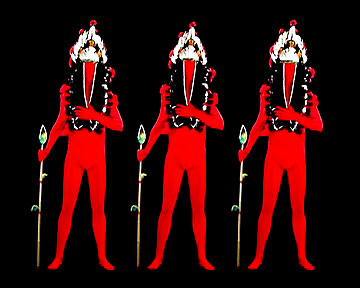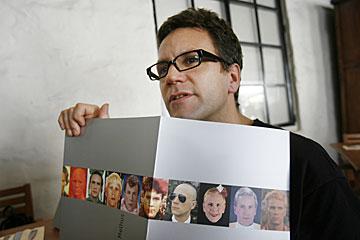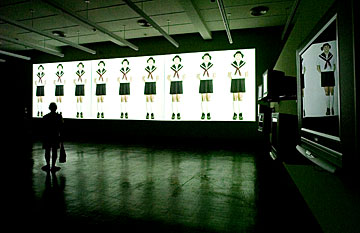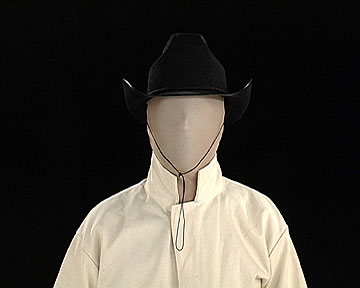
COURTESY HONOLULU ACADEMY OF ARTS
"Three Redskins," by German video artist Bjorn Melhus.
|
|
An alternative to 'Geisha' takes a realistic look at ubiquitous racial stereotypes
I DON'T KNOW about you, but I'm getting a little sick of the geisha thing. Maybe it takes a Westerner, isolated from any "real" Japan, to find this stereotype compelling. Maybe it's because, growing up Asian in America, you get a little too intimate with those cardboard cousins you're always being asked to meet -- the samurai warriors and karate experts, Confucian sages and, yes, geisha clattering by on their wooden shoes in the comic book history of the world.
Doesn't it bother people that these clichés, reinflated by Hollywood every few years, are as flat as cowboys and Eskimos and hula girls? The much-hyped, awards-season extravaganza "Memoirs of a Geisha" suggests not. Even in a Pacific crossroads such as Honolulu, this Orientalist fantasy fluttering with silk, fans, umbrellas and cherry blossoms has Asia fetishists lining up at the multiplexes.
For those who can't stomach this kind of pabulum, German video-maker Bjorn Melhus offers a titillating, snappy alternative that can be sampled in a considerably shorter running time at the Honolulu Academy of Arts.

GEORGE F. LEE / GLEE@STARBULLETIN.COM
"We always think we have the knowledge because we get this import of certain stereotypes," Bjorn Melhus says of the themes he raises in "Eastern Western Park," an installation on exhibit at the Honolulu Academy of Arts. "It's like the whole world turns more and more into a big theme park."
|
|
Melhus, 39, who constructs video fables based on American television, diverges in "Eastern Western Park" from his usual fare of talk shows, televangelists, home shopping and other cultural artifacts, to our adolescent fantasies about East and West.
His video installation fills the academy's contemporary gallery with a wall-size projection in which a strange ritual takes place, starring a Japanese schoolgirl, a cowboy and an Indian -- all played, as always, by Melhus himself. The same loop plays on a bank of video monitors on one wall, while the other wall is obscured by a life-size, reflective silver tepee containing a ring of video monitors that cast televised campfire flickers against the interior.
How does "Eastern Western Park" serve as an antidote to the blockbuster movie? Let us consider the ways:
1. "Memoirs of a Geisha," based on a fictional autobiography by a white guy from Massachusetts, has been criticized for casting Chinese actresses to speak English with a Japanese accent. Apparently the ridiculous effect breaks the spell of verisimilitude and disrupts the aesthetic appeal of the movie.
Melhus' video, on the other hand, draws attention to the fact that its characters are drawn purely from stereotypes in the artist's head. The cowboy and Indian, who do rhythmic movements to corny soundtracks, are taken from a television series popular in the Germany of his childhood that was, in turn, based on novels by a 19th-century author who had never set foot in America.
"We have this German author (Karl May) who had this idea of the Wild West of America -- he invented this exotic something out there -- and my knowledge of Japan is maybe the same knowledge that Karl May had about the Wild West," Melhus said last week.
"We always think we have the knowledge because we get this import of certain stereotypes. It's like the whole world turns more and more into a big theme park."
Melhus' Japanese schoolgirl is also plainly "not a Japanese schoolgirl -- it's a 40-year-old guy in a schoolgirl uniform," the artist says. "So this is not child's play; what is it? We are in limbo. It's a play with these grotesque icons."
The aesthetic appeal of the video, in other words, is precisely the power of the fake.
2. The musical and visual references in "Geisha" all work to prop up a collective fantasy about the mysterious, cruel, exotic East, which seems real to us because it has been built up through decades of movies, TV characters and advertising images that package Asia in a way that's immediately palatable.
Melhus' sources, while also recognizable as stereotypes, carry some breach that makes them both familiar and, as he puts it, grotesque. Rather than create a seamless fantasy to fix our attention on a fabulous world "out there," "Eastern Western Park" holds up a cracked mirror to ask what it is we are consuming.

CINDY ELLEN RUSSELL / CRUSSELL@STARBULLETIN.COM
As always, the characters in Bjorn Melhus' video installations are played by himself, including that of a Japanese schoolgirl.
|
|
"It's a comic book; it's very two-dimensional," he says of his video narrative. "This was another very important thing for me -- to leave it as a billboard, so there is no three-dimensional space; everything is just flat. It says all the time, 'Eastern Western Park,' but where is it? It's the billboard for itself."
3. Ultimately the difference between the two viewing experiences is in their effect. Director Rob Marshall's exquisite vision of war-era Kyoto seduces the audience into lapping up his Oriental reverie without too much thought. Blockbuster movies, like commercial TV, leave viewers ready to consume more of the same, whether it's bland entertainment or another product that conjures a closeted daydream to life.
In Melhus' videos, the images and especially the sound trigger a similar recognition, which he then perverts by splicing, altering and multiplying, as in sampled dub or hip-hop music.
The result falls somewhere between music videos, the visual "skins" that move to the beat of digital audio players and commercials designed to get a song stuck in your head. It's a bizarre, hypnotic effect that, rather than suck you into a fantasy, might make you look askew at the illusions you are being sold every time you turn on the tube.
THIS ESTRANGING effect is just what attracted Academy of Arts Director Stephen Little to Melhus' work.
"We're bombarded, especially through television, with all kinds of propaganda, and we're not being taught to assess it," he explained.
Melhus, who brings a German awareness of propaganda to American television -- two excellent examples of which are screening in a separate gallery near the museum entrance -- "asks some very probing questions about what is of value in our culture today, (which) lead to some rather dark corners," Little said.
"But he does it in a humorous, light way that masks the darkness."
Far from donning the slavish solemnity of an Oriental courtesan, "Eastern Western Park" finds in our mutual illusions a bit of campy fun.
Its silly East-West domination fantasy turns a teasing spotlight on the audience hidden in the darkened theater, hinting with a wink: The real subject of this amusement park is you.

CINDY ELLEN RUSSELL / CRUSSELL@STARBULLETIN.COM
'BJORN MELHUS: EASTERN WESTERN PARK'
» On view: Through Jan. 29
» Place: Honolulu Academy of Arts
» Hours: 10 a.m. to 4:30 p.m. Tuesdays through Saturdays, 1 to 5 p.m. Sundays
» Admission: $7; seniors, students, military $4
» Call: 532-8700 or visit www.honoluluacademy.org
|
|

